Introduction
In recent years, glyphosate-tolerant crops have promoted the repetitive and large-scale use of this herbicide. The occurrence of glyphosate-resistant weed biotypes is directly related to the development and expansion of glyphosate-tolerant crops because of the high selection pressure of these biotypes due to the continued use of this herbicide (Albrecht et al., 2014).
For effective control of weeds and prevention of the appearance of resistant weed biotypes, the use of two or more herbicides with different mechanisms of action is recommended. It is important to use new technologies that confer tolerance to different herbicides, thus, providing conditions for the rotation of mechanisms of action (Riar et al, 2013), as well as the association of herbicides as an important tool in weed management (Gemelli et al, 2013).
The second generation of glyphosate-tolerant maize is represented by the event NK603 (Roundup Ready™ 2 - RR2), approved in the USA and Brazil in 2000 and 2008; and the event MON87427 (Roundup Ready™), first approved in the USA in 2013 and later in 2016 in Brazil (Albrecht et al., 2021; ISAAA, 2021). Glyphosate tolerance is conferred by the expression of the cp4 epsps gene derived from the Agrobacterium tumefaciens strain CP4; this gene encodes a 5-enolpyruvylshikimate-3-phosphate synthase (EPSPs) insensitive to glyphosate (Nielsen et al., 2004).
T25 maize (Liberty Link® - LL) shows tolerance to the glufosinate herbicide. The tolerance is conferred by the gene pat, from the bacterium Streptomyces viridochromogenes (Matsuoka et al., 2001). In addition, maize with insect resistance (TC1507 maize) also shows tolerance to glufosinate, since the pat gene was used as a marker during its selection (Silva et al, 2017; Albrecht et al, 2021).
With the expansion of areas with glyphosate-tolerant and glufosinate-tolerant maize (RR2/LL), doubts have arisen regarding their association with other herbicides. In some situations, glyphosate is associated with other herbicides or other pesticides; and crop injury may occur (Albrecht et al., 2014). If the mixtures of some herbicides have undesirable effects even in crops with tolerance, as highlighted by Taiz and Zeiger (2010), negative effects on plant growth and development can occur. This is plausible when we consider the recent use of RR2/LL maize by Brazilian farmers.
For maize, as alternative herbicides or as a complement to glyphosate, atrazine (mechanism of action of PSII inhibitors) can be highlighted. It can be applied in the pre- or post-emergence of the crop, with an effect on eudicotyledonous weeds in pre-emergence or post-initial (Barnes et al., 2020; Langdon et al., 2021); and it is selective for maize (Giovanelli et al., 2018).
Araújo et al. (2021) do not observe reductions in yield or 100-grain weight or changes in nutrient contents, even with the use of high rates of glyphosate and glufosinate in RR2/ LL maize. Silva et al. (2017) observe injury >5% in maize, for glyphosate (1080 g acid equivalent [ae] ha-1), glufosinate (500 g active ingredient [ai] ha-1) and atrazine (2000 g ai ha-1), applied alone and in mixtures. Other studies suggest possible undesirable effects of the herbicide application in maize, such as symptoms of injury, when glyphosate was applied in mixtures with other herbicides (Giovanelli et al., 2018; Soltani et al, 2018).
Glyphosate, glufosinate, and atrazine do not affect the growth and development of RR2/LL maize plants; however, the results are less certain for these herbicides in mixtures. The present study aimed to evaluate the effects of the post-emergence application of atrazine, glyphosate and glufosinate, alone and in mixtures, on the growth and development of glyphosate and glufosinate-tolerant maize.
Materials and methods
Experimental conditions
The first experiment was conducted from January to March of 2014 in Piracicaba, São Paulo (SP, Brazil) (experiment I). The experiment was then repeated from January to March of 2015 in Palotina, Paraná (PR, Brazil) (experiment II). The treatments consisted of the application of glyphosate (1080 g of acid equivalent [ae] ha-1), glufosinate (500 g of active ingredient [ai] ha-1), atrazine (2000 g ai ha-1), glyphosate + glufosinate, glyphosate + atrazine, glufosinate + atrazine, glyphosate + glufosinate + atrazine, and the control (without application), thus, totaling eight treatments. Commercial products were used: Roundup Ready® (480 g ae of glyphosate L-1, Monsanto), Finale® (200 g ai of glufosinate L-1, Bayer), and Proof® (500 g ai of atrazine L-1, Syngenta).
Simple hybrids 2B810PW and 30F53HR were used in the experiment I and II. Both show resistance to lepidopterans and tolerance to glyphosate and glufosinate. The hybrids were chosen because they were suitable for the localities and mainly because they represented representative cultivated areas in Brazil.
The experiments were conducted in a completely randomized design with four replicates, up to 28 d after application (DAA). The pots for plant growth had a capacity of 7 L, with one plant per pot, and they were kept in a greenhouse at 25°C, relative humidity 60% and 5 mm day-1 of irrigation.
Physical and chemical analysis of soil was carried out as recommended by Donagema et al. (2011). The soil used for the experiment I showed the following results: pH (CaCl2) = 5.3; Al = 0.0 cmolc dm-3, H+Al = 2.50 cmolc dm-3, C = 10.27 g dm-3; P (resin) = 7.0 mg dm-3; K = 0.26 cmolc dm-3; Ca = 3.90 cmolc dm-3; Mg = 1.60 cmolc dm-3; sum of bases (SB) = 5.76 cmolc dm-3. The clay, sand, and silt contents were 40%, 54%, and 6%, respectively. For the experiment II, the physical and chemical analysis of the soil used showed the following results: pH (CaCl2) = 5.5; Al = 0.0 cmolc dm-3,H+Al = 4.28 cmolc dm-3, C = 5.39 g dm-3; P (Mehlich) = 8.93 mg dm-3; K = 0.51 cmolc dm-3; Ca = 5.39 cmolc dm-3;Mg = 0.87 cmolc dm-3; SB = 6.77 cmolc dm-3. The clay, sand, and silt contents were 65.7%, 17.8%, and 16.5%, respectively. All pots were kept free from weed interference through manual control.
The applications of the treatments were carried out in the V4 phenological stage (Ritchie et al., 1993), recommended for application of the herbicides used in the experiment. A CO2 pressurized backpack sprayer was used, with a constant pressure of 2 bars, equipped with a bar 2 m wide, containing four fan-like tips (XR 110.02, Teejet®) that, working at a height of 50 cm from the target and at a speed of 1 m sec-1, provided a spray volume of 200 L ha-1.
Data collection
Chlorophyll indexes were evaluated at 7, 14, 21, and 28 DAA. For the experiment I, a portable meter (SPAD-502, Konica Minolta, Inc., Japan) was used that evaluates the intensity of the green leaves and calculates the SPAD index that is highly correlated with the total chlorophyll content of leaves (Uddling et al., 2007). For the experiment II, the indexes of chlorophyll a, b, and total (a + b) were measured. For this, an electronic chlorophyll meter (clorofiLOG - CFL1030, Falker Automação Agrícola Ltda., Brazil) was employed that determined the Falker chlorophyll indexes (FCI) (Barbieri Junior et al., 2012). The measurement was always performed on the first fully developed leaf.
Also, at 7, 14, 21, and 28 DAA, symptoms of injury were evaluated. These assessments were carried out through visual analysis at each experimental unit considering significantly visible symptoms of the plants according to their development. Scores from 0% to 100% were assigned, where 0 represented the absence of symptoms and 100% the death of the plant (Velini et al., 1995). Treatment without application (without herbicide effect) was used as a reference for evaluations. On the same four dates, the height of the plants and stem diameter were evaluated (for the experiment I, stem diameter was assessed only at 28 DAA). Height measurements were made from the soil surface to the last fully open leaf with the ligule visible, and the stem diameter was measured 4 cm above the soil.
At 28 DAA, the fresh mass of shoots and the dry mass of roots, shoots and total (roots + shoot) were determined. The shoots were cut at ground level, with subsequent weighing to determine the fresh mass. The soil with the plant roots was removed from the pots, and the roots were separated from the soil with the aid of running water and sieves. For drying, a greenhouse with forced ventilation was used for 72 h at 65°C. To measure the weights, an analytical balance with a precision of three decimal places was used.
Statistical analysis
The results were tested for normality (Shapiro-Wilk test) and homogeneity (Levene test) and then tested by analysis of variance by the F-test (P<0.05), according to Pimentel-Gomes and Garcia (2002). The means of the treatments were compared by the Tukey's test (P<0.05). For this purpose, the Sisvar 5.6 software was used (Ferreira, 2011).
Results and discussion
Experiment I
For plant height evaluations, a significant difference was found in the evaluation at 28 DAA; treatment 6 had shorter plants than treatments 2 and 3, while the SPAD index evaluated at 7, 14, 21, and 28 DAA did not significantly differ between the treatments (Tab. 1).
TABLE 1 Height and chlorophyll index of maize plants at 7, 14, 21, and 28 d after application (DAA) of herbicides alone and in mixtures. Experiment I, Piracicaba, SP Brazil, 2014.
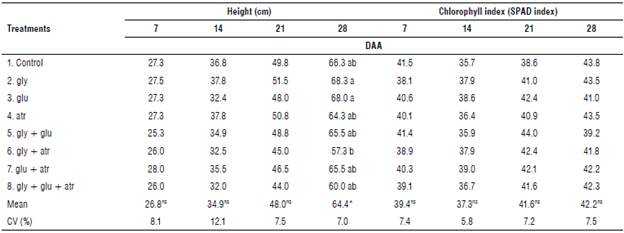
gly (glyphosate - 1080 g ae ha-1), glu (glufosinate - 500 g ai ha-1), atr (atrazine - 2000 g ai ha-1). CV - coefficient of variation. * Significant at 5% by the F test. ns not significant (P<0.05). Means followed by the same letter in the column did not differ significantly (P<0.05) according to the Tukey's test.
The test of means for the fresh weight of the shoots showed that treatment 8 (triple association) had a lower mass than treatments 1, 2, and 5. In relation to the dry weight of the shoot, treatment 8 expressed a lower mass than treatments 1, 2, 5, and 7 (Tab. 2).
TABLE 2 Stem diameter (SD), fresh weight of shoot (FS), dry weight of shoot (DS), dry weight of roots (DR), and total dry weight (TD) of maize plants at 28 d after application of herbicides alone and in mixtures. Experiment I. Piracicaba, SP Brazil, 2014.
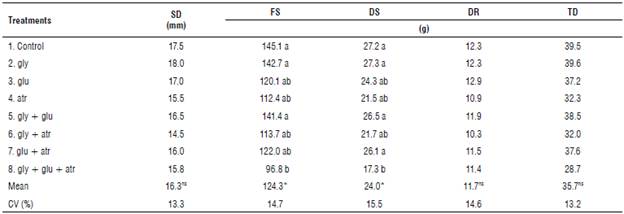
gly (glyphosate - 1080 g ae ha-1), glu (glufosinate - 500 g ai ha-1), atr (atrazine - 2000 g ai ha-1). CV - coefficient of variation. * Significant at 5% by the F test. ns not significant (P<0.05). Means followed by the same letter in the column did not differ significantly (P<0.05) according to the Tukey's test.
These results indicated a potential negative effect for the association of the three herbicides (treatment 8) applied on the RR2/LL maize. The absence of visual symptoms of injuries on the plants (0%) is worth mentioning, a fact confirmed by the lack of significant differences between treatments in the plant height and SPAD index.
Experiment II
For plant height evaluations (Tab. 3), a significant difference was observed at 7, 14, and 28 DAA, with emphasis on treatment 8 that was significantly lower than the treatments 4, 5, 6, 7 (7 DAA), 1, 3, 4, 5 (14 DAA), and 1, 3 (28 DAA). In the stem diameter evaluations, the analysis of the variance was not significant for all the evaluated periods.
TABLE 3 Height and stem diameter of maize plants at 7, 14, 21, and 28 d after application (DAA) of herbicides alone and in mixtures. Experiment II, Palotina, PR, Brazil, 2015.
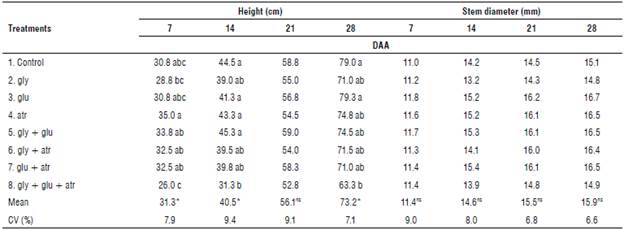
gly (glyphosate - 1080 g ae ha-1), glu (glufosinate - 500 g ai ha-1), atr (atrazine - 2000 g ai ha-1). CV - coefficient of variation. * Significant at 5% by the F test. ns not significant (P<0.05). Means followed by the same letter in the column did not differ significantly (P<0.05) according to the Tukey's test.
Table 4 shows the chlorophyll indexes. For these, a significant difference was observed at 14 DAA in which treatment 5 had a lower significant index than treatment 2. For the chlorophyll b indexes, the significant difference in the evaluation at 14 DAA occurred in treatment 7. A mean lower than treatment 2 and the means of treatments 4 and 5 were significantly lower when compared to treatments 1 and 2. In the total chlorophyll indexes at 14 DAA, the difference was significant for treatment 5 and the mean was significantly lower than that in treatments 1 and 2.
TABLE 4 Chlorophyll a, b, and total in maize plants at 7, 14, 21, and 28 d after application (DAA) of herbicides alone and in mixtures. Experiment II, Palotina, PR, Brazil, 2015.
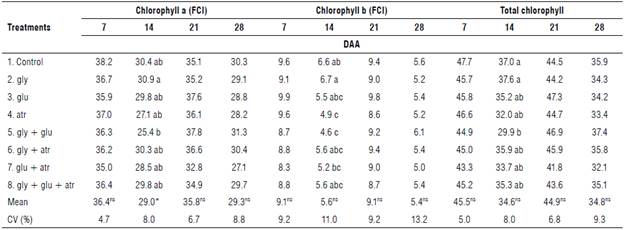
FCI (Falker chlorophyll index), gly (glyphosate - 1080 g ae ha-1), glu (glufosinate - 500 g ai ha-1), atr (atrazine - 2000 g ai ha-1). CV - coefficient of variation. * Significant at 5% by the F test.ns not significant (P<0.05). Means followed by the same letter in the column did not differ significantly (P<0.05) according to the Tukey's test.
There are two predominant forms of chlorophylls a and b that differ slightly in structure. The main function of chlorophyll is to convert light energy into chemical energy, a process that occurs in the chloroplasts (Streit et al., 2005). These variables are important in terms of understanding selectivity and connections with plant development. The application of glyphosate associated with glufosinate (treatment 5) resulted in a lower chlorophyll a, b, and total index at 14 DAA than only applying glyphosate (treatment 2). This indicates the possibility of a negative effect on the association of the two products applied to the RR2/LL maize. The reduction in the chlorophyll content can be an indicator for investigating an injury to the plants (Song et al., 2007). This is an important aspect for study, considering the immense potential of using these transgenic technologies that confer tolerance to herbicides (RR2/LL) and, at the same time, the lack of research results in this sense.
For the fresh weight of shoots and total dry weight of plants, treatment 8 had a lower weight than treatment 5 (Tab. 5). Despite the use of a different hybrid in experiment II, the pattern of behavior observed in the first experiment was maintained. One of the main responses to emphasize is the potential for damage related to the application of glyphosate, glufosinate and atrazine (treatment 8) to the RR2/LL maize.
TABLE 5 Fresh weight of shoot (FS), dry weight of shoot (DS), dry weight of roots (DR), and total dry weight (TD) of maize plants at 28 d after application of herbicides alone and in mixtures. Experiment II, Palotina, PR, Brazil, 2015.
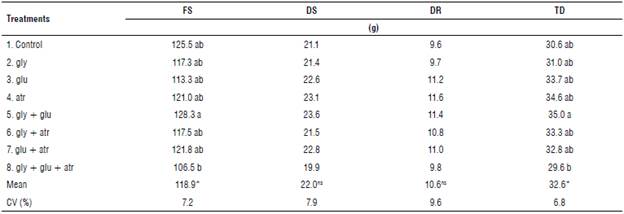
gly (glyphosate - 1080 g ae ha-1), glu (glufosinate - 500 g ai ha-1), atr (atrazine - 2000 g ai ha-1). CV - coefficient of variation. * Significant at 5% by the F test.ns not significant (P<0.05). Means followed by the same letter in the column do not differ significantly (P<0.05) according to the Tukey's test.
We emphasize that visual analysis of crop injury was performed in both experiments, but not including notes, as no visual symptoms of injury were perceived. This confirms the results for the chlorophyll indexes, for which reductions were observed only at 14 DAA for the application of glyphosate + glufosinate in experiment 2. At 21 and 28 DAA no further reductions were observed. These findings are in line with those reported by Chahal and Jhala (2018) and Giovanelli et al. (2018), in which the high selectivity is linked to the high expression levels of the pat gene.
As already mentioned, in both experiments, the main highlight was the significant reduction observed in the fresh and dry weight of shoots for the treatment with the mixture of three herbicides (treatment 8), thus, being an indication to avoid this practice. It should be noted that there are no results in the literature in this sense. So, this study must be widened and repeated.
The application of atrazine did not damage the maize, confirming information in the literature (Dan et al., 2010; Giovanelli et al., 2018; Giraldeli et al., 2019; Richburg et al., 2020) and for LL maize. In the latter case, atrazine was used in combination with glufosinate (Silva et al., 2017). In the relevant literature, there are no reports of glyphosate damage in RR2 maize and, when reported, usually, they have higher rates than the one that was considered in this study (Gemelli et al., 2013; Albrecht et al., 2014; Langdon et al., 2020). The same fact occurs with glufosinate, alone or in mixtures, in which no harmful effects were observed in LL maize (Silva et al., 2017; Krenchinski et al, 2019).
Another aspect to be highlighted is that TC1507 maize hybrids (insect resistant) may have different levels of tolerance to glufosinate. The pat gene, as already mentioned, was used as a marker in the selection process of this event. According to Krenchinski, Carbonari, et al. (2018), the expression of the pat gene may vary according to the trademark of the hybrid, thus, hybrids with greater expression of the pat gene show greater tolerance to glufosinate.
The selectivity of glufosinate, alone or in mixtures, is known for maize in other studies (Lindsey et al., 2012; Ganie & Jhala, 2017). In these studies, the maize hybrids were T14 or T25 events, that is, the LL technology (properly said) guarantees a good level of selectivity in the maize plants.
Insect-resistant maize hybrids that also show tolerance to glufosinate have been marketed in Brazil for several years (Borém, 2015). In recent years, in Brazil, tolerance to glufosinate is increasingly used in the management of weeds in post-emergence of insect-resistant maize (Albrecht et al., 2021), with good levels of tolerance to glufosinate, as demonstrated in this study.
The herbicide mixtures, in the RR2/LL maize hybrids, are a practice that needs to be preserved. Shaner (2000) already emphasizes that the intensive use of glyphosate in RR crops could lead to problems, especially, in the selection of resistant biotypes. Therefore, it is important to use technologies that confer tolerance to different herbicides, thus, providing favorable conditions for the rotation of action mechanisms (Gage et al., 2019; Summers et al., 2021). Results showing the advantages of the use of glufosinate-tolerant maize become another option for the control of weeds in this productive system (Armel et al., 2008; Everman et al., 2009; Krenchinski, Albrecht, et al, 2018).
Conclusions
Herbicides applied alone or in binary mixtures did not cause major damage. However, the application of the three associated herbicides in some situations may result in detrimental effects on the development of the RR2/LL maize. These herbicides in mixtures were generally safe for maize and could be considered for weed management. These mixtures have a broad spectrum of action for the control of weeds and may be important in the management of weeds resistant to herbicides. However, caution is important when using triple mixtures in the field, given the possible deleterious effects.














